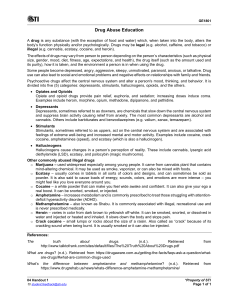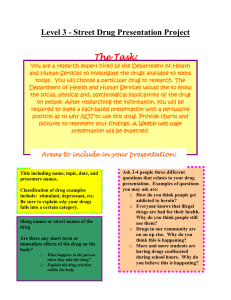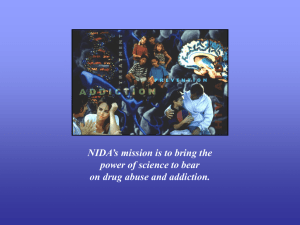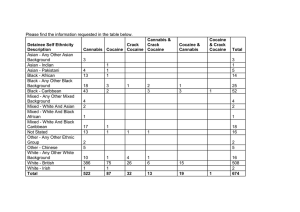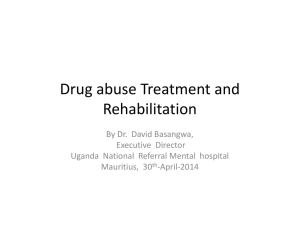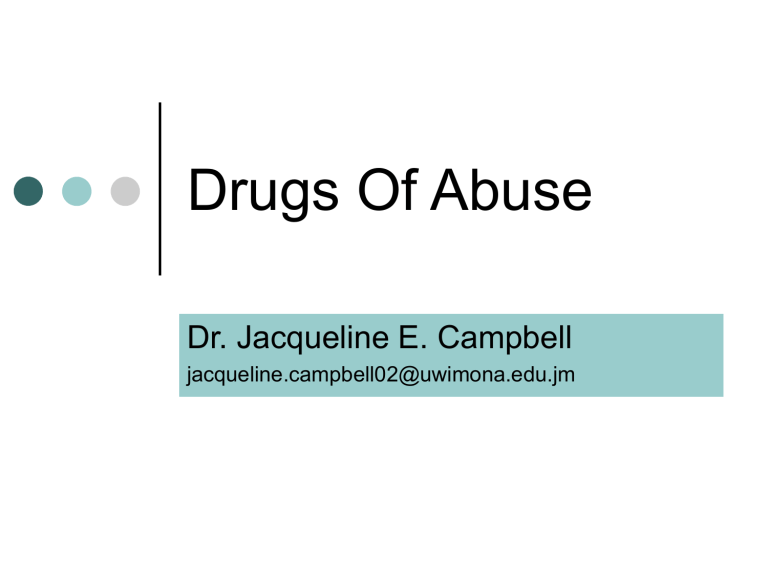
Drugs Of Abuse Dr. Jacqueline E. Campbell jacqueline.campbell02@uwimona.edu.jm DRUG ABUSE Refers to the use , usually by self administration of any drug in a manner that deviates from the approved medical or social patterns within a given culture. ( Jerome Jaffe , 1980 ) Criteria for drug abuse Use of any prohibited drug Intentional taking of any therapeutic drug in amounts greater than prescribed Excessive use of licit social drugs Use of any therapeutic drug for other than its intended purpose (s) Taking of two or more intoxicating substances in combination in order to obtain a more pleasurable or intense “ high “ Abuse potential ✓ ✓ ✓ Abuse potential of any given drug will depend on the degree to which these various factors interact to promote or limit widespread abuse Intrinsic dependence liability drug’s fundamental propensity to produce physiological or psychological dependence Availability of drug within society Inherent harmfulness of drug wrt direct physical & psychological effects it produces in user Drug with abuse potential • • • • • • Socially acceptable – alcohol , caffeine nicotine Opioid analgesicsmorphine , heroin Sedative / hypnotics Hallucinogens Inhalants Club drugs / designer drugs • • • Stimulants – cocaine amphetamines Cannabis Performance enhancing drugs Role of Dopamine Although different classes of psychoactive substances have different primary pharmacological MOA , dopamine – important in development of dependence of all classes b/cause of its crucial role in response – reinforcement learning Drugs Natural re-enforcers in much the same way as Food Water Sex Pleasurable effects produced by a drug will increase probability that it will be taken again Role of Dopamine All psychoactive substances w reinforcing properties activate mesolimbic dopamine directly or indirectly DA released in response to unexpected reward ► reinforcing of behaviours that led to occurrence of that reward Mesolimbic dopamine system Repeated use of cocaine or heroin( morphine) can deplete dopamine from system ► resulting in normal rewards losing their motivational significance Abstinence From cocaine or heroin (morphine ) after repeated administration ► ↓ dopamine levels in mesolimbic system --- intense craving assoc w withdrawal Craving related to relapse following abstinence Coca leaves & cocaine hydrochloride powder Cocaine Indirect sympathomimetic – potentiates NE / epinephrine by blocking reuptake of catecholamine at adrenergic n terminals Effects noted generally result of drugs’ stimulant properties Patterns of cocaine use Cocaine hydrochloride – snorting (intranasal), smoking, intravenous (including being mixed with heroin (‘speedball’ or ‘snowball’)), ingestion, application to genitalia Crack cocaine – inhalation of vapour from heated foil or pipe Freebasing Coca leaves – chewed/ ingested Crack usu. made by mixing 2 parts cocaine HCl w 1 part baking soda (sodium bicarbonate) in about 20 ml H2O solution then heated gently until white precipitates form heating halted when precipitation stops precipitate filtered & retained; may then be washed w water product then dried for 24 hours under heat-lamp. Crack then cut or broken into small 'rocks' weighing a few tenths of a gram. can be smoked in crack pipes, or heated on foil & vapour inhaled Rocks of crack cocaine Freebase cocaine Changes cocaine hydrochloride into smokeable & more potent form Make cocaine hydrochloride alkaline by adding a base , then extracting cocaine base from mixture using organic solvent Solvent must be evaporated before being smoked Effects- Cocaine CNS : general stimulation → euphoria , dysphoria followed by depression Depression of medullary centers → death CVS : small doses→ bradycardia via central vagal stimulation ; moderate doses→ tachycardia , vasoconstriction , arrhythmia , MI Local anesthetic : blocks Na + ion channels → nerve fiber conduction Thermoregulation : pyrogenic EFFECTS OF LONG-TERM USE BINGES FOLLOWED BY CRASHES FORMICATION SLEEP DISORDERS-insomnia followed by exhaustion EATING DISORDERS – appetite suppression alternating w intense hunger SEXUAL DYSFUNCTION – impotence NEUROLOGICAL EFFECTS-cerebral atrophy EFFECTS OF LONG -TERM USE CARDIOVASCULAR – high blood pressure, arrhythmias INFECTIONS MISCARRIAGES PREMATURE DELIVERY LOW BIRTH WEIGHT BABIES Pharmacokinetics Detection of accumulation of cocaine metabolites in hair possible in regular users until the sections of hair grown during use are cut or fall out. Cocaine extensively metabolized primarily in the liver, with only about 1% excreted unchanged in the urine Half life – 50 mins Metabolism – hydrolysis of its 2 ester groups Major urinary metabolite benzoylecgonine found in urine 2 to 5 days after a binge COCAINE- treatment of overdose 1. Beta blockers => for autonomic hyperactivity. 1 blockade (Atenolol, metoprolol, esmolol and non-selective : labetolol) • This treatment is controversial: Problems with using non-selective blockers may lead to unopposed a effects => BP 2.Nitroglycerine or other nitrites/nitrates ➔ for angina 3. Calcium channel blockers (verapamil, diltiazem) ➔ for hypertension 4.Ice baths ➔ for high fever 5. Acidify urine ➔ to hasten excretion COCAINE After the acute toxic effects are handled: ⚫ Antidepressants ➔ for depression ⚫ Haloperidol ➔ for psychosis ⚫ Alprazolam ➔ for panic attacks AMPHETAMINES d, l-Amphetamine Methylphenidate (Ritalin®, use to treat attention deficit and hyperactivity disorders in children) Phendimetrazine (used to treat obesity) Methamphetamine (“crystal”, “speed”, “ICE”) Methylendioxyamphetamine, (MDA) Methylenedioxymetamphetamine, (MDMA, ecstasy, XTC) AMPHETAMINES Pharmacology: • Present accepted clinical therapeutic use, in narcolepsy and ADDH • Sometimes used as antidepressants and to treat obesity (anorectic) => can cause dependence. Abuse: • Amphetamine and methamphetamine -HCl (speed), => I.V. • D-methamphetamine (“ice”) => smoked like cocaine but has a much longer duration of action. AMPHETAMINES Acute toxicity/Overdose: Tachycardia, arrhythmias, hypertension, vomiting, depression (prolonged), seizures, hyperthermia Treatment i.v benzodiazepines i.v nitrates Methamphetamine Methamphetamine Most methamphetamine precursors - common household products include pseudoephedrine, antifreeze, lithium batteries, muriatic acid, salt, ether Methamphetamine – “Lab “ Methamphetamine Long term neurological effects – stereotypical movements , psychotic behaviour , long term CVS effects GIRL WHO GOUGED OUT EYES WHILE HIGH ON CRYSTAL METH SAYS LIFE IS 'MORE BEAUTIFUL' NOW Cannabis sativa MARIHUANA (CANNABIS) Pharmacology From the Indian hemp plant, or Cannabis sativa. Medicinal powers => Egyptians. Probably originated in Central Asia. Delta-9-tetrahydrocannabinol (THC) is the active ingredient. Marihuana, marijuana, bhang, ganja, hashish or charas, sinsemilla, red oil. Cannabis Effects of short term use – low to moderate doses CNS , behavioural , subjective Cardiovascular Respiratory GI Cannabis Effects of short-term use – higher doses CNS , behavioural , subjective Synesthesias Pseudohallucinations Impaired judgment Reaction time slowed Cannabis Effects of short term use – higher doses True hallucinations Delusions Depersonalization Cannabis At very high doses --- acute toxic psychosis characterized by hallucinations , paranoid delusions, disorientation , intense feelings of depersonalization, severe agitation , loss of insight Cannabis - long term use Psychological effects - occasional , low dose use does not appear to produce harmful psychological effects in healthy adults Risk of pronounced psychological dependence high among users w emotional problems who turn to cannabis to relieve psychological stress Cannabis - long term use Amotivational syndrome ???? Manifestation of chronic intoxication Other effects – respiratory system – bronchitis , asthma , lung cancer CANNABIS High lipid solubility but does not dissolve well in water so if taken orally they are absorbed through the digestive system rather slowly. Smoking causes 50% of cannabinoids to enter the lungs. Holding the smoke in the lungs maximizes absorption. Pharmacokinetics Effect of cannabis – smoked – takes about 1 hr to develop fully Intoxication produced by a single typical joint lasts about 45 minutes Effect of cannabis –taken orally – may last up to 24 hrs Pharmacokinetics Small fraction converted to 11hydroxy – THC which is more active than THC itself Most converted to inactive metabolites Partly conjugated , undergoes enterohepatic recirculation THC & metabolites highly lipophilic & sequestered in body fat Cannabinoids > 60 Bind to specific cannabinoid receptors CB1 , CB2 CB1 receptors anti – nociceptive effects in animal studies Occur in hippocampus , cerebellum, substantia nigra Mesolimbic dopamine pathways ( reward ) Peripherally in heart & uterus CB2 receptors Peripherally in spleen , lymphoid system , modulate lymphocyte function Produce anti – nociceptive effects vs inflammatory pain Cannabinoids Adverse effects Detection periods Assoc w CB1 receptor stimulation Span 4 – 6 days in acute users ; 20 – 50 days in chronic users The Poison We Pick Andrew Sullivan This nation pioneered modern life. Now epic numbers of Americans are killing themselves with opioids to escape it. http://nymag.com/daily/intelligencer/2018/02/ameri cas-opioid-epidemic.html Opium, heroin, morphine, and a universe of synthetic opioids, including the superpowerful painkiller fentanyl, are its proliferating offspring. More than 2 million Americans are now hooked on some kind of opioid, and drug overdoses — from heroin and fentanyl in particular — claimed more American lives last year than were lost in the entire Vietnam War. http://nymag.com/daily/intelligencer/2018/02/americas-opioidepidemic.html Heroin Heroin or diacetylmorphine 3,6-diacetyl derivative of morphine Routes of administration Sniffing Smoking Swallowing Injection – i.v injection produces most rapid & intense response to drug Heroin- physical dependence Can develop very rapidly for regular high dose user Heroin- physical dependence / withdrawal Onset typically occurring 6 – 12 hours after last dose Symptoms include Watery eyes Runny nose Yawning Sweating Above stage followed by phase called “ yen “ – agitated sleep that may last several hours On awakening agitation continues accompanied by depression , loss of appetite , dilated pupils, tremors Heroin- physical dependence / withdrawal Peak intensity Usu 36 – 72 hours after last dose of heroin Bouts of chills , shivering alternating w bouts of flushing & excessive sweating Goose flesh highly prominent ( plucked turkey ) Insomnia Heroin- physical dependence / withdrawal Violent yawning , sneezing NV , intestinal spasm , diarrhoea , pain in bones , muscles Uncontrolled kicking movements ( kicking the habit ) Severity of symptoms grad ↓ , most symptoms not present 5 – 10 days after onset of withdrawal sickness Heroin – psychological dependence Can persist long after signs of withdrawal sickness have disappeared Chronic depression Anxiety Insomnia Loss of appetite Periods of agitation & continued craving for drug may last for periods of months / even years Inhalants Breathable chemical vapors that users intentionally inhale because of chemicals' mind-altering effects Often common household products that contain volatile solvents, aerosols, or gases Inhalant abuse worldwide problem often affects younger children vs other forms of substance abuse crosses social & ethnic boundaries Inhalants important factors that promote use in a young age group Inhaled substances - widely available, convenient, inexpensive, easily concealed, & legal for specific intended uses but are intentionally misused by abusers Pharmacologic Classification of Inhalants Volatile solvents, fuels, and anaesthetics (air blast, discorama, hippie crack, medusa, moon gas, oz, poor man’s pot) Solvents: toluene, acetone, methylene chloride, ethyl acetate, TCE in paint thinner, paint & polish removers, correction fluid & felt-tip marker fluid; TCE & tetrachloroethylene in degreasers, spot removers, & dry-cleaning fluids; toluene, hexane, TCE, ethyl acetate, & methyl chloride in glues & rubber cement; propellants & solvents such as butane, propane, chlorofluorocarbons, hydrocarbons in aerosol spray paint, computer/electronics-cleaning spray, spray deodorant, hair spray, vegetableoil cooking spray, air-freshener spray, fabric-guard spray, & analgesic sprays Fuels: butane or propane lighters or pressurized fuel tanks, gasoline, racing car octane boosters, refrigerants Anaesthetics: nitrous oxide,ether, halothane, enflurane, ethyl chloride TCE 1,1,1-trichloroethane Reference Williams, J.F., Storck, M., & the Committee on Substance Abuse and Committee on Native American Child Health (2007) : Inhalant Abuse. Pediatrics,119 (5) ,1009-17. Jamaica In Jamaica anecdotal reports – nail polish, glue, “white out” – most commonly abused solvents Produce rapid high that resembles alcohol intoxication Designer & club drugs Manufactured by chemically altering controlled substances Designer & club drugs Hallucinogens - MDMA – methylenedioxymethamphetamineecstasy Methamphetamine Ketamine Date rape drugs – gamma – hydroxybutyrate ( GHB ) & Flunitrazepam ( Rohypnol ) Inhalants Hallucinogens - MDMA – ecstasy synthetic drug that has hallucinogenic & stimulant properties @ low doses – hallucinogenic effects predominate @ higher doses – amphetamine like effects experienced taken orally as a capsule or tablet Hallucinogens - MDMA – ecstasy Amphetamine like effects of MDMA result in alertness & energy Leads to malignant hyperthermia , rhabdomyolysis , kidney failure , hypertension, tachycardia, arrhythmias, anxiety, psychosis, death Ecstasy- other effects nausea, chills, sweating, teeth clenching, muscle cramping, blurred vision Hallucinogens Cannabis LSD ( lysergic acid diethylamide ) Mescaline Psilocybin DMT ( dimethyltryptamine ) LSA ( d – lysergic acid amide ) Hallucinogens MDA ( methylenedioxyamphetamine ) MDMA ( methylenedioxymethamphetamine ) – ecstasy PMA ( paramethoxyamphetamine ) STP Harmaline , Harmine TMA Hallucinogens Amanita muscaria (fly agaric mushroom ) Nutmeg Peyote Angel’s trumpet Bufotenin Catnip Ibogaine Angel’s Trumpet Prescription drug abuse Taking prescription medication not prescribed for individual / taking it for reasons or in dosages other than as prescribed Commonly abused classes of prescription medications include opioids (for pain), CNS depressants (for anxiety & sleep disorders), stimulants (for ADHD & narcolepsy) Prescription drug abuse Opioids hydrocodone (Vicodin®) oxycodone (OxyContin®) propoxyphene (Darvon®) hydromorphone (Dilaudid®) meperidine (Demerol®) diphenoxylate (Lomotil®)

